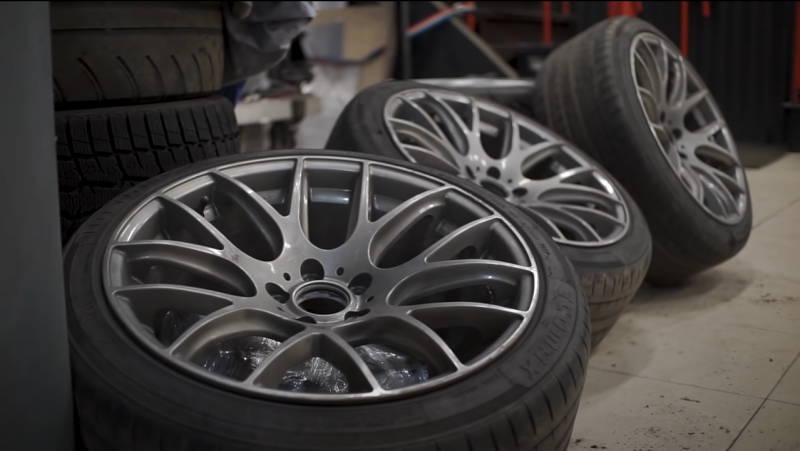The model was created by PSA in close cooperation with Toyota. As a result of collaboration, in March 2005, at the Geneva Motor Show, three almost identical city cars were presented to the public: Toyota Aygo, Peugeot 107 and Citroen C1.

Citroen C1 is a typical city car. Photo: youtube.com
A reliable Japanese engine and chassis, dressed in a French exterior and interior design, aroused buyers' interest in the miniature hatchback. Externally, the Citroen C1 stands out in city traffic, while it is economical and inexpensive to maintain.
Half a V6 under the hood – pleasant dynamics with ridiculous fuel consumption
Under the hood of the first generation Citroen C1 is most often a 998 cc inline three-cylinder Toyota engine. see Power 68 hp enough to provide the dynamics of a small hatchback. European buyers were also offered a diesel version with a four-cylinder 1,4-liter engine producing 54 hp. With. This version was not officially supplied to Russia.
The petrol C1 is equipped with a 5-speed manual transmission or robotic automatic transmission. The latter causes much more complaints from owners, so it is preferable to choose the manual option. This model is more economical and boasts better speed performance. The Citroen C100 with a manual transmission accelerates to 1 km/h in 13,7 seconds, while the robotic transmission increases the acceleration time by 1 second.

Citroen C1 boasts good dynamics. Photo: youtube.com
When driving in the city, the tiny Frenchman with a Japanese heart consumes 5,5 liters of gasoline per 100 km, and when driving on the highway at speeds of up to 100 km/h, fuel consumption is a ridiculous 4 liters per hundred.
During its release, the model underwent two restylings, and in 2012 the second generation C1 was presented to the public. A fellow member of the Peugeot concern received a new model index 108. The main changes affected the appearance and interior of the cars. In the line of power plants, instead of a diesel engine, a gasoline 82-horsepower 1,2-liter French PSA engine was offered.

Citroen C1 2nd generation is practically not sold in Russia. Photo: youtube.com
This version did not gain popularity, since buyers preferred the already familiar and proven liter Japanese engine from Toyota.
Rare versions of the Citroen C1
Being a direct descendant of the legendary 2CV, the Citroen C1 also often appeared on the sports track. A small, but durable and dynamic car, it easily competed with rivals of equal size and characteristics. Over the 17 years of production of the model, several sports versions were presented.

Citroen C1 often participated in sports competitions. Photo: youtube.com
Perhaps the most interesting C1 was the version with the GT-C1 index, to the creation of which the famous designer Franco Sbarro had a hand. Wide wheel arches, gullwing doors and a 1,6-liter engine turned the modest minicar into a real sports car.
In 2016, Citroen introduced a pseudo-sports version of the Furio, but the changes affected only the design of the car. Critics have rightly noted that the bright decals, sporty alloy wheels and the message of the brand's sports heritage do not make the tiny hatchback a car for the race track.
The list of small-scale versions of the C1 also includes electric vehicles created on its basis in the UK and compact commercial vans C1 Enterprise, sold in Greece and Portugal.
Features of operation of Citroen C1: pros and cons of a minicar
The Citroen C1 can be called a destroyer of the myth about the unreliability of French cars. The German automobile club ADAC in its annual breakdown statistics gave first place in class A in 2010 to the Japanese-French trio Peugeot 107/Toyota Aygo/Citroen C1. The owners of these cars visited car repair shops much less often than the owners of the Fiat Panda, Chevrolet Matiz or Smart Fortwo.

Toyota Aygo is a twin of the French hatchback. Photo: youtube.com
Judging by the reviews on the largest domestic sites, Russian owners of the Citroen C1 confirm the high reliability rating from ADAC. Many argue that for 50 and even 100 thousand kilometers the Frenchman did not require serious repairs, and the costs were reduced to the purchase and replacement of consumables.
In addition to reliability, the Citroen C1 pleases its owners with its efficiency. According to publications in the German press, in 2010 the model ranked second in terms of efficiency among cars with gasoline engines with an average of 4,8 liters per 100 km, second only to the Toyota Prius hybrid. Despite the overall positive impression of the Citroen C1, the car is not without its shortcomings.

The interior of the Citroen C1 is simple and ascetic. Photo: youtube.com
They cannot be called critical, but must be taken into account when purchasing. Key comments from drivers to the little Frenchman:
✅ low ground clearance, there is a risk of scratching the bumper on the curb when parking
✅ too simple and ascetic interior with cheap plastic
✅ poor sound insulation of the cabin
In addition, owners of models with a robotic automatic transmission complain about the operation of the transmission. The version with a manual transmission does not cause such complaints. Despite the general reliability of the Citroen C1, in Russian realities problems arise with the steering rack, clutch and suspension elements.
After approximately 90 thousand km, the wheel bearings need to be replaced. The clutch will require replacement after 80-100 thousand km in the case of a manual transmission. Incorrect operation of the robotic transmission leads to problems with the clutch after 30 thousand km. The remaining repair work for most owners comes down to replacing consumables: spark plugs, brake pads, headlight bulbs and filters.
A little about prices for Citroen C1 and spare parts for it
On the Russian used car market, the majority of Citroen C1s presented are of the first generation, produced in 2008–2013. Copies with minor flaws are valued at slightly less than 400 thousand rubles. For example, a compact French hatchback 2011 with a non-working parking brake and a broken trunk lock is offered for 380 thousand. The average price for a car that does not require investment varies between 450-500 thousand rubles.

A Citroen C1 in good condition costs about half a million rubles. Photo: youtube.com
The most expensive C1 is priced at 750 thousand rubles, but, according to the seller, the problem of interior noise insulation has been eliminated in the car, and the problematic robotic automatic transmission has been adapted to Russian conditions. The Peugeot 107 twin costs the same, but the Toyota Aygo, under equal conditions, is priced at 20% more expensive.
Owners in large cities should not have any problems finding spare parts for the Citroen C1. Any parts, both original and analogues, are available for sale. Their prices are significantly lower than, for example, spare parts for German or American cars. Let us remind you that the Frenchman’s problem area is considered to be the clutch. The original set (disc, basket and release bearing) produced by PSA costs about 30 thousand rubles. A budget analogue from Patron will cost only 8 thousand, but it is still preferable to use original parts.
The original steering rack, which also often requires replacement, costs 13 thousand rubles. The wheel bearing mentioned above costs from 1,5 to 5 thousand rubles, depending on the manufacturer. The cost of consumables is also affordable and will not ruin the owner of a French hatchback.

Citroen C1: cheap, economical, but gentle on potholes. Photo: youtube.com
To summarize, we can say that the Citroen C1 is a good choice for use in the city. This maneuverable hatchback with a bright appearance stands out in the crowd, and its modest dimensions do not cause problems with parking. Low fuel consumption, minimal transport tax, reliability and inexpensive spare parts compensate for the minor shortcomings of this car.










